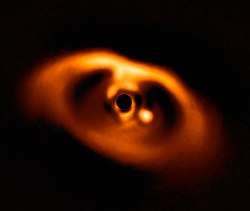Hot Neptune
A hot Neptune or Hoptune[1] is a type of giant planet with a mass similar to that of Uranus or Neptune orbiting close to its star, normally within less than 1 AU.[2] The first hot Neptune to be discovered with certainty was Gliese 436 b in 2007, an exoplanet about 33 light years away. Recent observations have revealed a larger potential population of hot Neptunes in the Milky Way than was previously thought.[3] Hot Neptunes may have formed either in situ or ex situ.[4]
General characteristics
Because of their close proximity to their parent star, hot Neptunes have a much greater rate and chance of transiting their star as seen from a farther outlying point, than planets of the same mass in larger orbits. This increases the chances of discovering them by transit-based observation methods.
Transiting hot Neptunes include Gliese 436 b and HAT-P-11b. Gliese 436 b (also known as GJ 436b) was the first hot Neptune to be discovered with certainty in 2007. The exoplanet Mu Arae c (or HD 160691 c) discovered in 2004 might also be a hot Neptune, but it has not been determined definitively. Another may be Kepler-56b, which has a mass somewhat larger than Neptune's and orbits its star at 0.1 AU, closer than Mercury orbits the sun.[5]
The first theoretical study of how hot Neptunes could form was carried out in 2004.[6] If these planets formed ex situ, i.e., by migrating to their current locations while growing, they may contain large quantities of frozen volatiles and amorphous ices. Otherwise, if they formed in situ, their inventory of heavy elements should be made entirely of refractory materials.[4] Yet, regardless of the mode of formation, hot Neptunes should contain large fractions (by mass) of gases, primarily hydrogen and helium, which also accounts for most of their volume.[7][8]
See also
- Helium planet
- Hot Jupiter – Planet type
- Mini-Neptune
- Neptunian Desert
- Ocean planet
- Super-Earth – extrasolar planet with a mass higher than Earth's, but substantially lower than the Solar System's ice giants
References
- Dong; et al. (23 June 2017). "LAMOST telescope reveals that Neptunian cousins of hot Jupiters are mostly single offspring of stars that are rich in heavy elements". Proceedings of the National Academy of Sciences. 115 (2): 266–271. arXiv:1706.07807. doi:10.1073/pnas.1711406115. PMC 5777037. PMID 29284755.
- G. Wuchterl. "Hot Neptunes: A Key To Giant Planet Formation" (PDF). cosis.net. Retrieved 3 August 2015.
- Oligarchic formation of hot Neptunes
- D'Angelo, G.; Bodenheimer, P. (2016). "In Situ and Ex Situ Formation Models of Kepler 11 Planets". The Astrophysical Journal. 828 (1): id. 33. arXiv:1606.08088. Bibcode:2016ApJ...828...33D. doi:10.3847/0004-637X/828/1/33.
- "NASA Exoplanet Archive". NASA Exoplanet Archive. Operated by the California Institute of Technology, under contract with NASA.
- Adrián Brunini and Rodolfo G. Cionco (September 2005). "The origin and nature of Neptune-like planets orbiting close to solar type stars". Icarus. 177 (1): 264–68. arXiv:astro-ph/0511051. Bibcode:2005Icar..177..264B. doi:10.1016/j.icarus.2005.02.015.
- D'Angelo, G.; Durisen, R. H.; Lissauer, J. J. (2011). "Giant Planet Formation". In S. Seager. (ed.). Exoplanets. University of Arizona Press, Tucson, AZ. pp. 319–346. arXiv:1006.5486. Bibcode:2010exop.book..319D.
- D'Angelo, G.; Lissauer, J. J. (2018). "Formation of Giant Planets". In Deeg H., Belmonte J. (ed.). Handbook of Exoplanets. Springer International Publishing AG, part of Springer Nature. pp. 2319–2343. arXiv:1806.05649. Bibcode:2018haex.bookE.140D. doi:10.1007/978-3-319-55333-7_140. ISBN 978-3-319-55332-0.
Sources
- Gillon; et al. (September 2007). "Detection of transits of the nearby hot Neptune GJ 436 b". Astronomy and Astrophysics. 472 (2): L13–L16. arXiv:0705.2219. Bibcode:2007A&A...472L..13G. doi:10.1051/0004-6361:20077799.
- Paul Gilster (2007-05-16). "Transiting 'Hot Neptune' Found". Centauri Dreams. A discussion of the "Detection of transits of the nearby hot Neptune GJ 436 b" paper.
